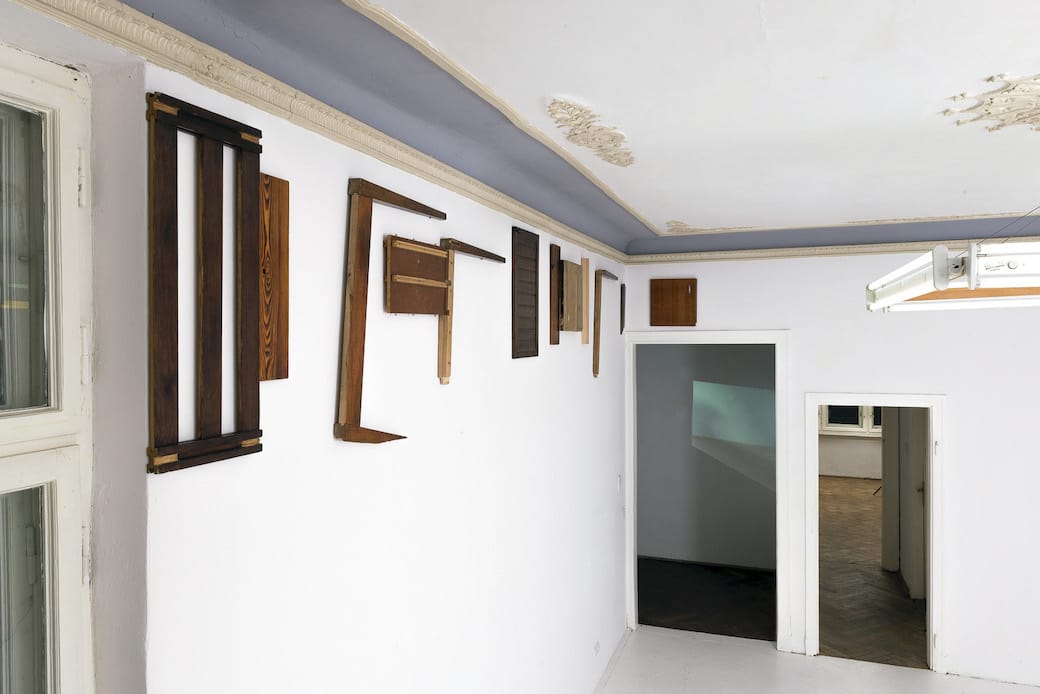JAN MIODUSZEWSKI / FABRYKA MEBLI
Zbieractwo i łowiectwo
Jan Mioduszewski od dawna kolekcjonuje przedmioty znalezione, znane w słowniku sztuk pięknych jako objéts trouvés. Oczywiście jest to dość wysublimowany rodzaj zbieractwa. Jego celem nie jest kolekcjonowanie samo w sobie, ale tworzenie asamblaży z elementów mebli, wcielanie się w bricoleur’a, przetwarzającego przedmioty w wielowątkowe prace. Działania Mioduszewskiego od momentu zbierania obiektów zyskują charakter performatywny, a artysta przyznaje się do swoistej gry, prowadzonej w tej dziedzinie z „konkurencją”, czyli innymi miłośnikami zbieractwa. Czasem, gdy widzi interesujący obiekt przykrywa go prowizorycznie innymi „gabarytami”, postanawiając zabrać ze sobą w drodze powrotnej. Zdaje sobie sprawę, że inni mogą go ubiec, ale ryzyko to traktuje jako element pracy.
Jan Mioduszewski uczynił z performansu element dopełniający jego malarstwo. Nawet jeśli czasem stanowi pozornie autonomiczną formę wypowiedzi, zawsze odnosi się do jego praktyk malarskich. Tym razem, na wystawie Zbieractwo i łowiectwo, Mioduszewski poszedł jednak o wiele dalej, angażując „performatywnie” samą publiczność, zapraszając ją dosłownie do wejścia w obraz, do stania się jego częścią. Gest ten jest kontynuacją rozważań artysty nad statusem obrazu,
a właściwie nad statusem obrazu i widza, który zostaje zachęcony do przyjęcia podwójnej roli: oglądającego i oglądanego. Tu zresztą kryje się pewna pułapka: pytanie jak bardzo „skończony”, czy też jak bardzo „nieskończony” jest asamblaż Mioduszewskiego bez zasiadającego w nim widza/performera? Czy ten aktywny odbiorca tworzy sens pracy Mioduszewskiego? Czy podejmując grę proponowaną przez artystę, staje się nim samym, autorem obrazu, czy tylko postacią wykorzystaną do odegrania przewidzianej roli?
„W miarę jak sztuka rozpuszcza się w życiu, obraz daje nam ogląd już nie tylko taki, jak okno w i na ścianie, lecz staje się przestrzenią trójwymiarową, w której owo twórcze rozpuszczenie może być poddawane próbie, rozgrywane, opowiadane, doświadczane.” – podpowiada Dieter Roelstraete. Mioduszewski nie ustaje w eksperymentach na samym procesie oglądania – prowokuje widza do wejścia na instalację-ambonę, a z niej każe mu łowić prace niedostępne dla wzroku z poziomu podłogi. Tym samym obrazy stworzone przez artystę z elementów mebli zebranych na śmietniku zostają złowione przez aktywnego odbiorcę-performera.
Na wystawie Zbieractwo i łowiectwo pokazujemy też zrekonstruowaną instalację Deski, listwy
z 2004. To wczesna, klasyczna już realizacja Fabryki Mebli, będąca świadectwem badania przez artystę sytuacji granicznej malarstwa, a także, a może przede wszystkim, jego zainteresowania iluzją i wciąganiem widza w wizualne rebusy. W realizacji tej artysta umieścił pod ścianą deski
i listwy z niewielkimi, trudnymi do rozpoznania interwencjami malarskimi. Najważniejszy stał się tu element gry z nierozpoznaniem, zanikaniem sztuki, jej wtapianiem się rzeczywistość. Ten moment zawieszenia, niemożności ostatecznego określenia statusu obiektu stanowi, jak się wydaje, kwintesencję twórczości Jana Mioduszewskiego.
______________________________________________
JAN MIODUSZEWSKI / FURNITURE FACTORY
Gathering and Hunting
Jan Mioduszewski has been collecting objets trouvés for a long time. Obviously, it is a rather sublime type of gathering. It does not aim at collecting per se, but at creating assemblages with furniture elements. Mioduszewski becomes personification of bricoleur transforming objects into multithreaded works. The artist’s activities, from the initial moment of gathering, have
a performative character; he admits to be playing a certain game with “competitors” in this field, that is, with other hoarders. Sometimes, when he finds an interesting specimen, he hides it under other large objects with the intention of collecting it on his way back. He realises that others can forestall him, but he sees taking the risk as a part of his work.
Mioduszewski often treats performance as complementary to his painting. Even when it seems to be an independent form of expression, it always refers to painterly practice. Here, at the Gathering and Hunting exhibition, the artist engaged the audience in a “performative” way, inviting them to literarily enter the painting. I see this gesture as a continuation of the artist’s deliberations on the status of painting. Or rather, on the status of painting and the viewer, who is encouraged to take on a double role: of viewer and someone being viewed. Besides, there is a trap in here: how incomplete is Mioduszewski’s assemblage without the presence of the viewer/performer? Does this active viewer determine the meaning of his work? Does the audience, by accepting the game proposed by the artist, become a co-author of the work, or are they only being taken advantage of to play a given part?
“As art blends into life, painting no longer provides a mere view by way of a window in and on the wall, but becomes a three-dimensional space in which this creative dissolution can be tested, played out, narrated, experienced.” – suggests Dieter Roelestreate. Mioduszewski continues his experiments on the viewing process by provoking the viewers to climb the installation-pulpit and hunt out the works which are not visible from the floor level. In this way the paintings created with furniture elements gathered from the rubbish are caught by the active viewer-performer.
The installation Planks, Battens (2004), early work by Furniture Factory, has been reconstructed for the Gathering and Hunting exhibition. This work is evidence of the artist exploring the boundaries of painting: what is more, his interest in illusion and drawing the audience into the visual rebus. Planks, Battens leaning against the wall, have small, difficult to spot painterly interventions. It is a game with non-recognition, with the vanishing of art, its blending into reality. This moment of “jamming”, the incapability of recognising an object’s status, appears to be the quintessence of Mioduszewski’s art.
















